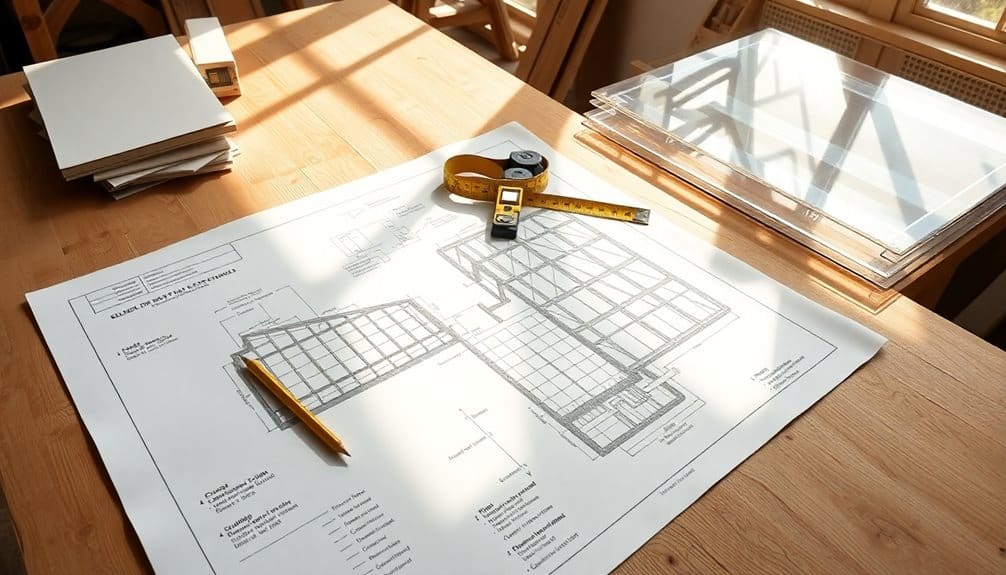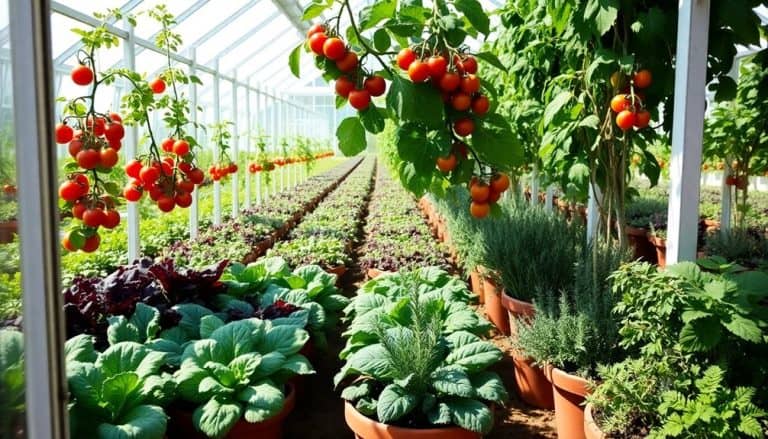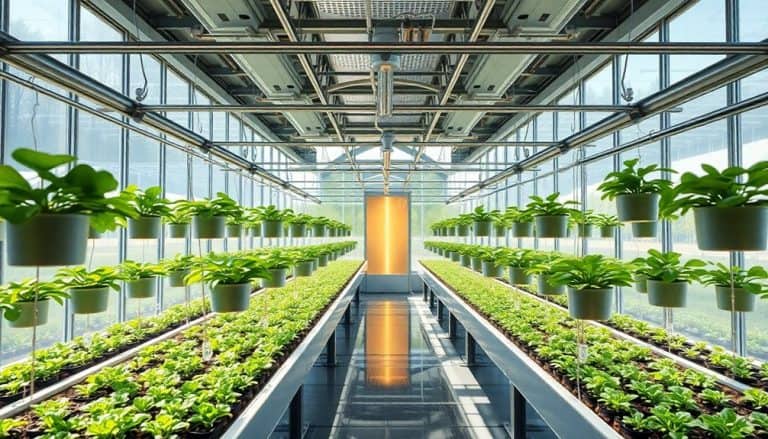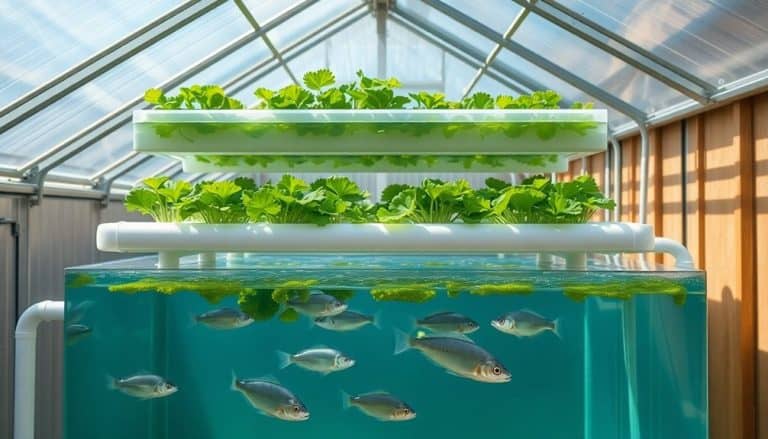This website contains affiliate links. Some products are gifted by the brand to test. As an Amazon Associate, I earn from qualifying purchases. The content on this website was created with the help of AI.
You’ll need to carefully plan your DIY greenhouse project by selecting an ideal site with 6-8 hours of southern exposure on an east-west axis. Start with detailed engineering drawings that account for proper drainage, ventilation, and structural integrity. Choose between lean-to, gable-roof, hoop house, or geodesic dome designs based on your space and climate requirements. Essential materials include UV-resistant polycarbonate panels, pressure-treated lumber, and ventilation components. Maintain precise construction methods, focusing on foundation stability and proper sealing. The integration of climate control systems, including HAF fans and LED misting, will guarantee your greenhouse’s long-term success. Exploring the technical specifications will enhance your greenhouse’s efficiency and productivity.
Key Takeaways
- Choose between four main greenhouse styles: lean-to, gable-roof, hoop house, or geodesic dome based on your space and budget requirements.
- Ensure proper site selection with 6-8 hours of direct sunlight and a 15-foot clearance from structures for optimal growing conditions.
- Use UV-resistant polycarbonate panels and pressure-treated lumber for durability, with proper ventilation systems installed every 20 feet.
- Install foundation with 2% grade slope for drainage, maintaining 7-foot minimum height and 4-foot post intervals for structural integrity.
- Implement climate control with LED misting systems and HAF fans to maintain 50-70% humidity and prevent temperature variations.
Planning Your Greenhouse Project
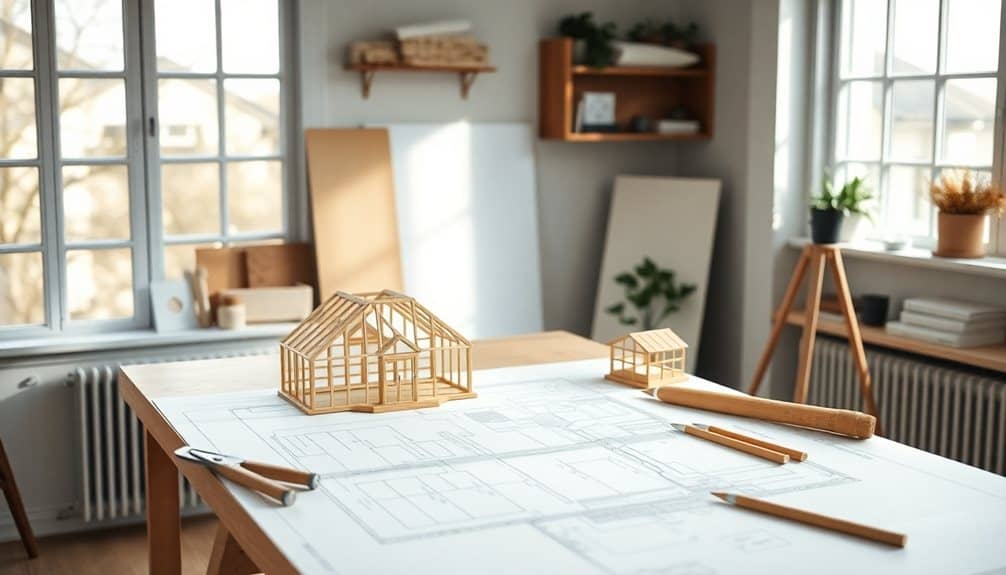
Before beginning greenhouse construction, you’ll need to address three critical planning elements: site selection, structural specifications, and local building regulations. Your site evaluation must account for solar orientation, ensuring maximum southern exposure in the Northern Hemisphere to enhance photosynthetic efficiency. Analyze topographical features and conduct soil percolation tests to assess drainage capabilities.
Your structural specifications require precise calculations for load-bearing capacity, wind resistance, and thermal efficiency. You’ll need to determine ideal dimensions based on your cultivation goals, maintaining a minimum height of 7 feet for proper air circulation and plant growth. Calculate your glazing requirements, selecting between polycarbonate panels (R-value: 2.0) or tempered glass (R-value: 0.95) based on your climate zone.
Verify local zoning requirements and obtain necessary permits before proceeding. Most jurisdictions require detailed engineering drawings showing foundation specifications, frame construction, and ventilation systems. You’ll need to comply with setback requirements and height restrictions. Document your planned irrigation system and electrical specifications if you’re incorporating automated climate controls. Create a detailed materials list with precise measurements and standardized component specifications. Consider installing adjustable roof vents and side windows to maintain optimal temperature control and prevent overheating during warmer months.
Types of DIY Greenhouses

When selecting a greenhouse design, you’ll encounter four primary architectural configurations: lean-to, gable-roof, hoop house, and geodesic dome structures. Each configuration offers distinct advantages and spatial considerations for your cultivation needs.
Lean-to greenhouses attach directly to an existing structure, utilizing the thermal mass of your home’s wall while maximizing space efficiency. They’re ideal for limited square footage and typically require less construction material. Gable-roof designs feature the traditional peaked roof configuration.
Quality models like the heavy-duty steel frame Quictent Premium can withstand winds up to 80 MPH when properly anchored.
Essential Materials and Tools

Building a DIY greenhouse requires a specific set of construction materials and specialized tools that you’ll need to gather before starting the project. Your essential materials list should include UV-resistant polycarbonate panels or greenhouse-grade polyethylene film, pressure-treated lumber for the base, galvanized steel or PVC pipes for the frame, and corrosion-resistant fasteners.
You’ll need to acquire basic construction tools: a circular saw, drill with multiple bits, measuring tape, level, post-hole digger, and adjustable wrench. For precision cutting of polycarbonate panels, you’ll require a fine-toothed saw blade or utility knife. Additional materials include silicone caulk for sealing joints, metal brackets for structural support, and a ventilation system comprising automatic vent openers and fans.
For the foundation, you’ll need concrete mix, gravel for drainage, and rebar for reinforcement. Don’t forget safety equipment: safety glasses, work gloves, and a dust mask. If you’re installing an irrigation system, collect PVC pipes, connectors, and a timer-controlled water source. Temperature control requires a thermometer and optional shade cloth for summer heat management. When selecting ventilation fans, choose models with IP-54 ratings or higher to ensure proper protection against moisture and dust in the greenhouse environment.
Site Selection and Preparation
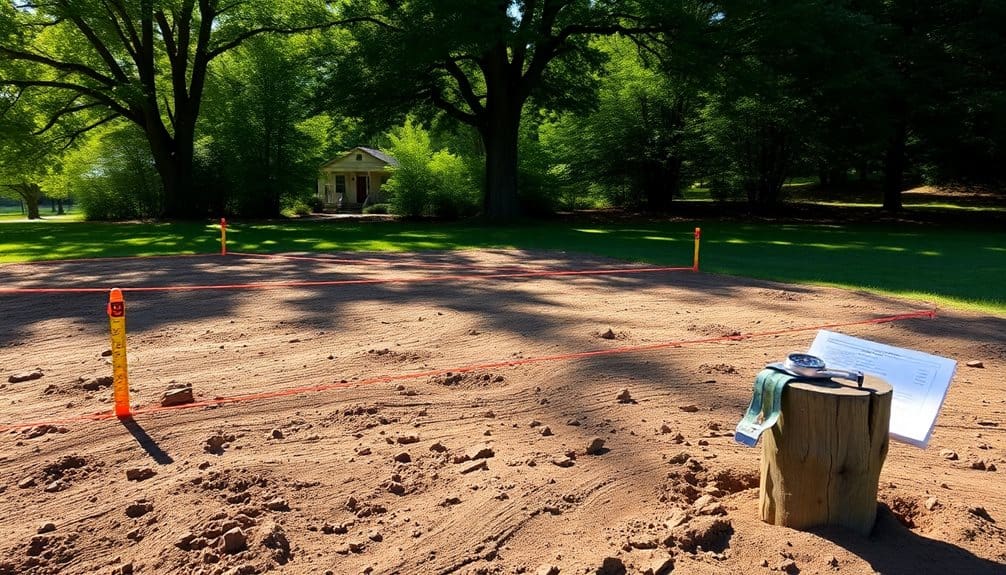
The ideal placement of your greenhouse determines its long-term success and efficiency. You’ll need to analyze several critical factors before breaking ground: solar orientation, topographical features, and accessibility to utilities.
Position your greenhouse on an east-west axis to maximize southern exposure, guaranteeing maximum solar gain during winter months. The structure should receive 6-8 hours of direct sunlight daily. You’ll want to maintain a minimum distance of 15 feet from tall structures or trees to prevent shadows and falling debris.
Begin site preparation by conducting a soil percolation test to assess drainage capabilities. You’ll need to excavate to a depth of 12 inches, removing all vegetation, roots, and rocks. Create a 2% grade slope away from the foundation to prevent water accumulation. Install a 4-inch layer of compacted gravel as your sub-base.
Survey your site’s proximity to water and electrical sources – you shouldn’t exceed 50 feet from these utilities. Consider prevailing wind patterns and incorporate windbreaks if you’re in an exposed area. The final grade should be 6 inches above the surrounding terrain to guarantee proper watershed management. Testing your soil’s pH between 6.0-7.0 will ensure optimal nutrient absorption for your greenhouse plants.
Step-by-Step Construction Guide
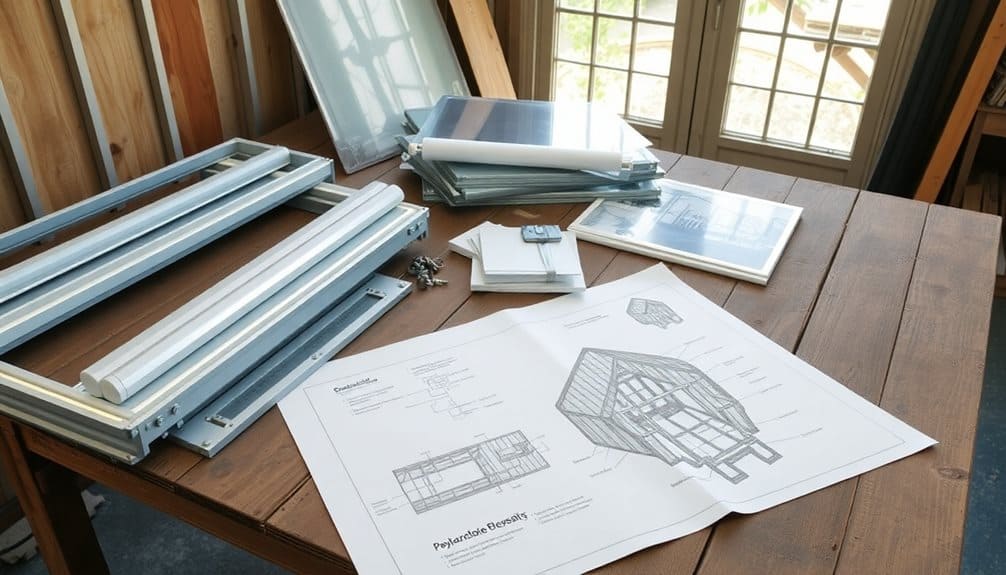
Ready to transform your site into a functional greenhouse? Begin by laying out your foundation perimeter using survey stakes and mason’s line, ensuring perfect 90-degree angles with the 3-4-5 triangulation method. Install your base frame using pressure-treated 4×4 lumber, securing it with galvanized lag bolts at each corner.
Next, erect your vertical support posts at 4-foot intervals, using a plumb bob to guarantee precise vertical alignment. Install horizontal purlins and ridge beam, calculating the ideal 30-degree roof pitch for maximum solar gain. You’ll need to secure each junction with galvanized steel brackets and appropriate fasteners.
Install your chosen glazing material—whether polycarbonate panels or greenhouse-grade polyethylene—working from bottom to top with proper overlap. Secure panels using UV-resistant glazing strips and thermally isolated fasteners. Don’t forget to integrate your ventilation system during frame construction, positioning automatic vent openers at the ridge and sidewalls.
Complete the structure by installing your entrance framework, ensuring proper clearance for doors. Seal all joints with appropriate weatherstripping and silicone caulk rated for extreme temperature variations. Test structural integrity before proceeding with internal systems installation. For optimal climate control, consider installing adjustable windows and vents which can help manage temperatures and maintain ideal growing conditions throughout the seasons.
Ventilation and Climate Control
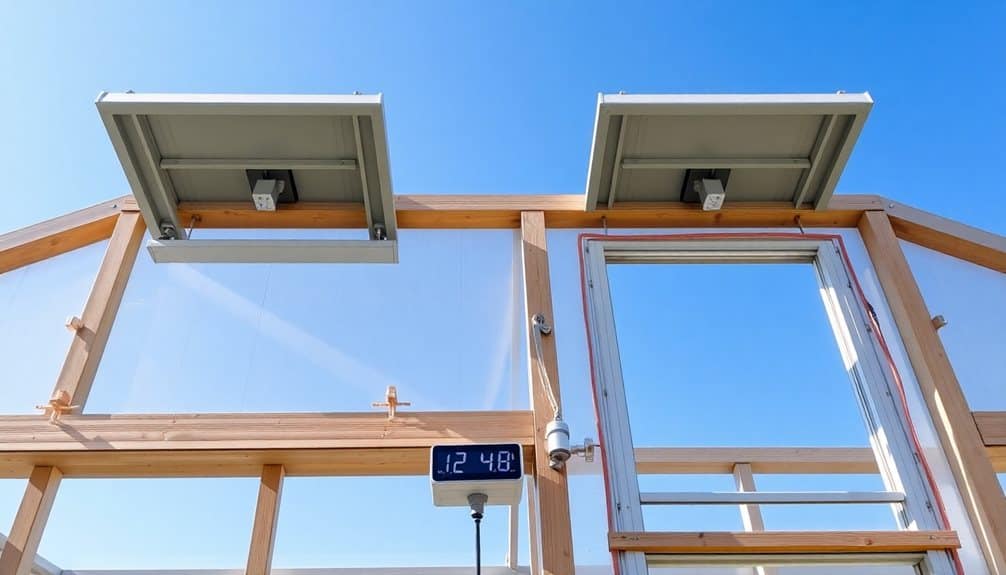
Now let’s address the critical components of greenhouse climate regulation through strategic ventilation placement and automated control systems. You’ll need to install both passive and active ventilation mechanisms to maintain ideal growing conditions. Position ridge vents at the highest point of your greenhouse to facilitate natural convection, while roll-up side panels should be placed along the length of both walls.
For active ventilation, mount 20-inch exhaust fans at one end, calculating 8 CFM (cubic feet per minute) per square foot of greenhouse space. Install inlet shutters on the opposite end to create proper cross-ventilation. You’ll want to connect these to a thermostat that triggers at 80°F (27°C).
To regulate humidity, incorporate a hygrostat-controlled misting system that maintains 50-70% relative humidity. Install horizontal air flow (HAF) fans every 20 feet to guarantee uniform air distribution and prevent microclimatic variations. During winter months, you’ll need a minimum of 2.5 BTUs per square foot per hour for heating. Connect all climate control components to a central environmental controller with data logging capabilities for precise monitoring and adjustment of growing conditions.
Frequently Asked Questions
How Long Does a DIY Greenhouse Typically Last Before Requiring Major Repairs?
Your DIY greenhouse’s longevity depends on the materials you’ll use and environmental conditions. With proper maintenance, polycarbonate panels typically last 10-15 years, while glass maintains integrity for 20-30 years. You’ll need to replace wooden frames every 10-20 years due to moisture damage, while aluminum or PVC frames can endure 20-30 years. UV degradation, wind stress, and humidity accelerate structural wear.
Can I Legally Build a Greenhouse Without a Permit in Residential Areas?
Like steering through a legal maze, greenhouse permit requirements can trip you up if you’re not careful. You’ll need to check your local zoning laws and building codes, as regulations vary considerably by municipality. Most residential areas require permits for structures exceeding 120 square feet, while temporary hoop houses under this threshold often don’t. Contact your local planning department to verify specific requirements and setback restrictions.
What Insurance Considerations Should I Keep in Mind for My Greenhouse?
You’ll need to reflect on three primary insurance components for your greenhouse: property coverage to protect against structural damage from weather events, contents coverage for your plants and equipment, and liability coverage if someone’s injured on your premises. It’s crucial to verify that your existing homeowner’s policy extends to detached structures, or you’ll need to obtain supplemental coverage specifically for the greenhouse installation.
How Much Can I Expect to Save Annually by Growing in Greenhouse?
Like a piggy bank filling with green treasures, your greenhouse can yield significant savings. You’ll typically save $500-$700 annually on produce costs when growing standard vegetables year-round. Factors affecting savings include your climate zone, crop selection, and growing efficiency. Calculate potential returns by multiplying your current monthly produce expenses by 0.4-0.6, as you’ll likely offset 40-60% of store-bought vegetables through greenhouse cultivation.
Are There Tax Benefits or Incentives for Building an Eco-Friendly Greenhouse?
You’ll find several tax benefits for eco-friendly greenhouse construction, including federal energy efficiency credits up to 30% for solar-powered systems, geothermal heating, and rainwater collection. State-level incentives vary but often include property tax exemptions, agricultural zone benefits, and renewable energy rebates. Many municipalities offer additional sustainability grants, while USDA’s REAP program provides 25% reimbursement for energy-efficient greenhouse systems.

